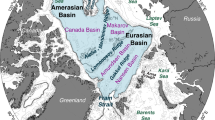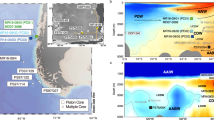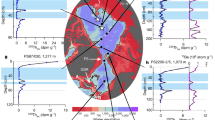Abstract
The Arctic Ocean has an important role in Earth’s climate, both through surface processes1 such as sea-ice formation and transport, and through the production and export of waters at depth that contribute to the global thermohaline circulation2,3. Deciphering the deep Arctic Ocean’s palaeo-oceanographic history is a crucial part of understanding its role in climatic change. Here we show that sedimentary ratios of the radionuclides thorium-230 (230Th) and protactinium-231 (231Pa), which are produced in sea water and removed by particle scavenging on timescales of decades to centuries, respectively4, record consistent evidence for the export of 231Pa from the deep Arctic and may indicate continuous deep-water exchange between the Arctic and Atlantic oceans throughout the past 35,000 years. Seven well-dated box-core records provide a comprehensive overview of 231Pa and 230Th burial in Arctic sediments during glacial, deglacial and interglacial conditions. Sedimentary 231Pa/230Th ratios decrease nearly linearly with increasing water depth above the core sites, indicating efficient particle scavenging in the upper water column and greater influence of removal by lateral transport at depth. Although the measured 230Th burial is in balance with its production in Arctic sea water, integrated depth profiles for all time intervals reveal a deficit in 231Pa burial that can be balanced only by lateral export in the water column. Because no enhanced sink for 231Pa has yet been found in the Arctic, our records suggest that deep-water exchange through the Fram strait may export 231Pa. Such export may have continued for the past 35,000 years, suggesting a century-scale replacement time for deep waters in the Arctic Ocean since the most recent glaciation and a persistent contribution of Arctic waters to the global ocean circulation.
This is a preview of subscription content, access via your institution
Access options
Subscribe to this journal
Receive 51 print issues and online access
$199.00 per year
only $3.90 per issue
Buy this article
- Purchase on Springer Link
- Instant access to full article PDF
Prices may be subject to local taxes which are calculated during checkout



Similar content being viewed by others
References
Rudels, B. in Encyclopedia of Ocean Sciences (eds Steele, J. H., Turekian, K. K. & Thorpe, S. A. ) 211–225 (Academic, 2009)
Aagaard, K., Swift, J. H. & Carmack, E. C. Thermohaline circulation in the Arctic Mediterranean Seas. J. Geophys. Res. 90, 4833–4846 (1985)
Rudels, B., Friedrich, H. J. & Quadfasel, D. The arctic circumpolar boundary current. Deep Sea Res. II 46, 1023–1062 (1999)
Henderson, G. M. & Anderson, R. F. The U-series toolbox for paleoceanography. Rev. Mineral. Geochem. 52, 493–531 (2003)
Cronin, T. M. et al. Deep Arctic Ocean warming during the last glacial cycle. Nature Geosci. 5, 631–634 (2012)
Yu, E.-F., Francois, R. & Bacon, M. P. Similar rates of modern and last-glacial ocean circulation inferred from radiochemical data. Nature 379, 689–694 (1996)
McManus, J. F., Francois, R., Gherardi, J.-M., Keigwin, L. D. & Brown-Leger, S. Collapse and rapid resumption of Atlantic meridional circulation linked to deglacial climate changes. Nature 428, 834–837 (2004)
Gherardi, J.-M. et al. Glacial-interglacial circulation changes inferred from 231Pa/230Th sedimentary record in the North Atlantic region. Paleoceanography 24, PA2204 (2009)
Bacon, M. P., Huh, C.-A. & Moore, R. M. Vertical profiles of some natural radionuclides over the Alpha Ridge, Arctic Ocean. Earth Planet. Sci. Lett. 95, 15–22 (1989)
Cochran, J. K., Hirschberg, D. J., Livingston, H. D., Buesseler, K. O. & Key, R. M. Natural and anthropogenic radionuclide distributions in the Nansen Basin, Arctic Ocean: scavenging rates and circulation timescales. Deep Sea Res. II 42, 1495–1517 (1995)
Scholten, J. C., Rutgers van der Loeff, M. M. & Michel, A. Distribution of 230Th and 231Pa in the water column in relation to the ventilation of the deep Arctic basins. Deep Sea Res. II 42, 1519–1531 (1995)
Edmonds, H. N., Moran, S. B., Cheng, H. & Edwards, R. L. 230Th and 231Pa in the Arctic Ocean: implications for particle fluxes and basin-scale Th/Pa fractionation. Earth Planet. Sci. Lett. 227, 155–167 (2004)
Trimble, S. M., Baskaran, M. & Porcelli, D. Scavenging of thorium isotopes in the Canada Basin of the Arctic Ocean. Earth Planet. Sci. Lett. 222, 915–932 (2004)
Hoffmann, S. S. & McManus, J. F. Is there a 230Th deficit in Arctic sediments? Earth Planet. Sci. Lett. 258, 516–527 (2007)
Moran, S. B. et al. 231Pa and 230Th in surface sediments of the Arctic Ocean: implications for 231Pa/230Th fractionation, boundary scavenging, and advective export. Earth Planet. Sci. Lett. 234, 235–248 (2005)
Ku, T.-L. & Broecker, W. S. Rates of sedimentation in the Arctic Ocean. Prog. Oceanogr. 4, 95–104 (1965)
Not, C. & Hillaire-Marcel, C. Time constraints from 230Th and 231Pa data in late Quaternary, low sedimentation rate sequences from the Arctic Ocean: an example from the northern Mendeleev Ridge. Quat. Sci. Rev. 29, 3665–3675 (2010)
Poore, R. Z., Ostermann, D. R. & McGeehin, J. Stable isotope data and AMS 14C dates from Arctic Ocean Section 1994 surface sediment transect and box core samples from the Mendeleyev Ridge area. Open-File Report 99–48 (USGS, 1999)
Darby, D. A., Bischof, J. F. & Jones, G. A. Radiocarbon chronology of depositional regimes in the western Arctic Ocean. Deep Sea Res. II 44, 1745–1757 (1997)
Schlosser, P. et al. The first trans-Arctic 14C section: comparison of the mean ages of the deep waters in the Eurasian and Canadian basins of the Arctic Ocean. Nucl. Instrum. Methods 123B, 431–437 (1997)
Östlund, H. G., Possnert, G. & Swift, J. H. Ventilation rate of the deep Arctic Ocean from carbon 14 data. J. Geophys. Res. 92, 3769–3777 (1987)
Scholten, J. C. et al. Advection and scavenging: effects on 230Th and 231Pa distribution off Southwest Africa. Earth Planet. Sci. Lett. 271, 159–169 (2008)
Lao, Y. et al. Transport and burial rates of Be-10 and Pa-231 in the Pacific Ocean during the Holocene period. Earth Planet. Sci. Lett. 113, 173–189 (1992)
Chase, Z., Anderson, R. F., Fleischer, M. Q. & Kubik, P. W. The influence of particle composition and particle flux on scavenging of Th, Pa and Be in the ocean. Earth Planet. Sci. Lett. 204, 215–229 (2002)
Siddall, M. 231Pa/230Th fractionation by ocean transport, biogenic particle flux and particle type. Earth Planet. Sci. Lett. 237, 135–155 (2005)
Luo, Y., Francois, R. & Allen, S. E. Sediment 231Pa/230Th as a recorder of the rate of the Atlantic meridional overturning circulation: insights from a 2-D model. Ocean Sci. Discuss 6, 382–400 (2010)
Roy-Barman, M. Modeling the effect of boundary scavenging on thorium and protactinum profiles in the ocean. Biogeoscience 6, 3091–3107 (2009)
März, C., Poulton, S. W., Brumsack, H.-J. & Wagner, T. Manganese-rich brown layers in Arctic Ocean sediments: composition, formation mechanisms, and diagenetic overprint. Geochim. Cosmochim. Acta 75, 7668–7687 (2011)
Anderson, R. F., Bacon, M. P. & Brewer, P. G. Removal of 230Th and 231Pa from the open ocean. Earth Planet. Sci. Lett. 62, 7–23 (1983)
Yu, E.-F., Francois, R., Bacon, M. P. & Fleer, A. P. Fluxes of 230Th and 231Pa to the deep sea: implications for the interpretation of excess 230Th and 231Pa/230Th profiles in sediments. Earth Planet. Sci. Lett. 191, 219–230 (2001)
Choi, M. S. et al. Rapid determination of 230Th and 231Pa in seawater by desolvated micro-nebulization inductively coupled plasma magnetic sector mass spectrometry. Mar. Chem. 76, 99–112 (2001)
Stuiver, M., Reimer, P. J. & Reimer, R. W. CALIB Radiocarbon Calibration. http://calib.qub.ac.uk/calib/ (version 5, 2005)
Hughen, K. A. et al. Marine04 marine radiocarbon age calibration, 26-0 ka BP. Radiocarbon 46, 1059–1086 (2004)
Fairbanks, R. G. et al. Marine radiocarbon calibration curve spanning 0 to 50,000 years B.P. based on paired 230Th/234U/238U and 14C dates on pristine corals. Quat. Sci. Rev. 24, 1781–1796 (2005)
Poore, R. Z., Osterman, L., Curry, W. B. & Phillips, R. L. Late Pleistocene and Holocene meltwater events in the western Arctic Ocean. Geology 27, 759–762 (1999)
Mangerud, J. & Gulliksen, S. Apparent radiocarbon ages of recent marine shells from Norway, Spitsbergen, and Arctic Canada. Quat. Res. 5, 263–273 (1975)
Butzin, M., Prange, M. & Lohmann, G. Radiocarbon simulations for the global ocean: the effects of wind stress, Southern Ocean sea ice and Heinrich events. Earth Planet. Sci. Lett. 235, 45–61 (2005)
Hanslik, D. et al. Quaternary Arctic Ocean sea ice variations and radiocarbon reservoir age corrections. Quat. Sci. Rev. 29, 3430–3441 (2010)
Mortlock, R. A. & Froelich, P. N. A simple method for the rapid determination of biogenic opal in pelagic marine sediments. Deep Sea Res. A 36, 1415–1426 (1989)
Francois, R., Frank, M., Rutgers van der Loeff, M. M. & Bacon, M. P. 230Th normalization: An essential tool for interpreting sedimentary fluxes during the late Quaternary. Paleoceanography 19, PA1018 (2004)
Jakobsson, M. Hypsometry and volume of the Arctic Ocean and its constituent seas. Geochem. Geophys. Geosyst.. 3, http://dx.doi.org/10.1029/2001GC000302 (2002)
Acknowledgements
We thank R. Poore for sharing radiocarbon dates for box cores 28 and 32. We thank O. Marchal, R. Newton, L. F. Robinson, D. McCorkle, E. Boyle, H. Oates and M. Jackson for discussions. The manuscript was improved by the comments of A. Thomas. This work was supported in part by the Comer Science and Education Fund and by US NSF grants OCE-0402565 (J.F.M.), OCE-0550637 (J.F.M.), OCE-0902985 (J.F.M.), AGS-0936496 (J.F.M.) and ARC-0520073 (W.B.C.).
Author information
Authors and Affiliations
Contributions
S.S.H. and J.F.M. designed the study with input from W.B.C. S.S.H. carried out core sampling, sediment digestions and instrumental analyses, and wrote the majority of the paper. S.B.-L. contributed to sediment digestion and analytical laboratory procedures. J.F.M. contributed to writing and revising the paper. All authors discussed the results and commented on the manuscript.
Corresponding author
Ethics declarations
Competing interests
The authors declare no competing financial interests.
Supplementary information
Supplementary Information
This file contains Supplementary Figures 1– 4, which illustrate comparisons of 231Pa/230Th ratios to Th-normalized sediment fluxes, and new and published Arctic coretop 231Pa/230Th data, a Supplementary Discussion, which gives further background about the isotopes and cores presented and additional references. (PDF 1463 kb)
Supplementary Tables
This file contains Supplementary Tables 1-5, which present coordinates for seven box cores, radiocarbon and calibrated ages used in constructing age models, radionuclide data and instrumental error bars for all nuclide measurements, biogenic silica contents for selected samples, and replicate 231Pa and 230Th concentrations used to construct typical external 1-sigma error bars for 231Pa/230Th ratios. (XLS 268 kb)
Rights and permissions
About this article
Cite this article
Hoffmann, S., McManus, J., Curry, W. et al. Persistent export of 231Pa from the deep central Arctic Ocean over the past 35,000 years. Nature 497, 603–606 (2013). https://doi.org/10.1038/nature12145
Received:
Accepted:
Published:
Issue Date:
DOI: https://doi.org/10.1038/nature12145
This article is cited by
-
Improvements in the determination of attogram-sized 231Pa in dissolved and particulate fractions of seawater via multi-collector inductively coupled plasma mass spectrometry
Progress in Earth and Planetary Science (2023)
-
Arctic deep-water anoxia and its potential role for ocean carbon sink during glacial periods
Communications Earth & Environment (2023)
-
No freshwater-filled glacial Arctic Ocean
Nature (2022)
-
Active Nordic Seas deep-water formation during the last glacial maximum
Nature Geoscience (2022)
-
Radioisotope constraints of Arctic deep water export to the North Atlantic
Nature Communications (2021)
Comments
By submitting a comment you agree to abide by our Terms and Community Guidelines. If you find something abusive or that does not comply with our terms or guidelines please flag it as inappropriate.



